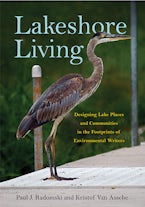In this remarkable and remarkably accessible synthesis of ecology, landscape design, and social sciences, the authors present an approach to lakeshore living that addresses the need to create rich, sustainable places and communities on the water, where both the loon and the family find a place, and where the cabin can be handed down with integrity to the grandchildren. Fragile shorelands require care, and that caring comes from knowledge, experience, and an environmental ethic. Radomski and Van Assche argue that an environmentally sensitive lakeshore place and community design is the way forward. While many factors affect the quality of lakes and lakeshore living, property owners and local communities do not have to wait until policies are perfect: the design approach advocated here can be applied in any place people living lakeside can get together and collaborate. The approach presented here is proactive and context sensitive: new designs have to fit the existing ecological, cultural, and policy landscapes. Development is always re-development in this sense. The authors introduce the reader step-by-step to this approach and carefully discuss leverage points that can be helpful in implementation and system change.
ContentsForeword by Randall ArendtPrefaceAcknowledgmentsProloguePart One - North American LakesChapter 1. Lake PartsChapter 2. Lake EcologyPart Two - Scientist, Writer, and ActivistChapter 3. Aldo Leopold and Living in Harmony with the LandChapter 4. Sigurd Olson and Protecting WildernessChapter 5. William Whyte and Human HabitatPart Three - Lakeshore Development and RedevelopmentChapter 6. Asset PreservationChapter 7. Asset CreationChapter 8. Connecting People and ThingsPart Four - Making Good Things Happen Around UsChapter 9. Culture and GovernanceChapter 10. System ChangingChapter 11. Our Lake, Our ResponsibilityNotes and Recommended ReadingReferencesIndex

